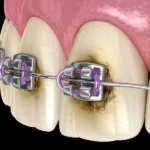Is root canal painful?

Tooth pain can be caused by many different problems, some of which require no dental treatment at all and others that can be very harmful if left untreated for any length of time. Knowing what causes tooth pain and when to see a dentist can help ensure you seek treatment at the right time. Here are the most common causes of tooth pain, how to identify them, and what steps should be taken to remedy them.
Table of Contents
1- Tooth Decay
Over time, bacteria in the mouth use sugars to make acid, which eats away at teeth and can result in decay, or the development of cavities. Cavities are holes in the teeth.
When caught early, cavities can be easily remedied by a simple restoration or filling, but when gone unnoticed, cavities can result in infection or permanent damage to the dental pulp, which requires more extensive treatment. In some cases, decay has done so much damage to the tooth that it must be extracted.
The pain caused by decay can be experienced in a few ways: 1) as a sharp pain upon biting down, or 2) as a lingering pain that lasts more than 30 seconds after exposure to hot or cold foods. Decay requires intervention from a dentist. If you believe you may have decay, schedule an appointment as soon as possible.
2- Abscess/Infection
An abscess is an often painful infection at the root of a tooth that results in the formation of a pus-filled sac. In many cases, tooth abscesses occur as a result of severe decay, but they can also result from trauma to the tooth, a crack or chip in the tooth, gum disease, or gingivitis. In severe cases, the infection may spread beyond the pulp and root of the tooth into surrounding bone and tissue.
An abscessed tooth is serious and typically requires treatment with antibiotics before dental work can be done. The treatment for an abscess is usually root canal treatment followed by either a filling or a crown. In some cases, the tooth must be extracted or further treatment is required.
The pain associated with an abscessed tooth is usually severe, continuous, and either sharp or throbbing, and may be accompanied by facial swelling and sensitivity to hot and cold. If you believe you may have an abscessed tooth, contact your root canal specialist as soon as possible.
3- Cracked Tooth
A tooth can crack as a result of trauma, biting into something very hard like a bone or rock, or decay. Some cracks are very challenging to find while others can be easily identified visually.
The treatment for a cracked tooth varies depending on the individual circumstances. A crack that affects only the crown of the tooth, such as a cusp fracture or a simple chip, can often be treated with a restoration. A crack that affects the pulp of the tooth requires root canal treatment, while a crack that extends into the root of the tooth requires extraction and replacement with a bridge, partial, or dental implant.
The pain experienced with a crack tooth is often most noticeable when chewing and may feel like a sharp pain when biting down or with the release of biting pressure. Catching a crack early can save the tooth; if you believe you may have a cracked tooth, schedule an appointment as soon as possible.
4- Bruxism
Bruxism is the medical term for grinding teeth. The pain associated with bruxism is often experienced as a dull ache in the upper jaw or teeth. The treatment for bruxism is often the use of a custom mouth guard at night.
If you believe you’re suffering from bruxism, your dentist can assist. Over-the-counter mouth guards and pain relievers may also help.
5- Recent Dental Work
Recent dental work can result in inflammation of the pulp of the tooth and/or the tissue surrounding the tooth. Novocaine or lidocaine injections can also cause soreness at the injection site.
Pain associated with recent dental work often surfaces as sensitivity to hot and cold and generalized soreness. Dental treatment is generally not necessary; take over-the-counter pain relievers.
Pain Relief After Root Canal Treatment
When the root canal treatment can be completed in one visit, pain can usually be minimized. In this case, an antibiotic is usually used after the treatment if there is a systemic sign of infection like a fever. The first step of minimizing pain simply has to do with taking care of the tooth during the treatment and minimizing trauma to periapical tissue. The tooth is kept dry and carefully sealed to avoid leakage. A good endodontist can make a big difference in how much pain the patient will experience by simply completing the procedure carefully and cleaning all the canals thoroughly.
Secondly, the irrigation process must be completed properly with sodium hypochlorite, EDTA, and Chlorhexidine. In many cases, it is best to irrigate with EDTA, wait a few moments and then come back and irrigate again. Proper irrigation will lead to less pain when the tooth is sealed later.
Finally, after the root canal treatment is completed and the tooth is sealed, the patient will be sent home with some pain medication. Ibuprofen is usually the drug of choice after a root canal treatment. Antibiotics are not usually recommended after root canal treatment unless there is a reason to suspect that it will be necessary like swelling and fever.
If the patient has ongoing pain after the procedure, he or she should always reach out to the endodontist. While some slight pain is normal, the pain should not get worse after the first couple of days. If the pain does get worse, it is a sign of secondary infection, and an antibiotic may need to be prescribed in this case.
How to control the pain during the root canal treatment?
Local anesthesia plays an integral role in root canal procedures. Without local anesthetic, endodontic treatment would be unbearable. Evidence-based research has proven techniques that allow patients to achieve profound and full “numbing” down to the very core of the tooth, known as profound pulpal anesthesia. Endodontists are considered the industry experts when it comes to achieving this level of local anesthesia because an endodontist deals with pain management as a routine part of their professional careers.
The anatomy of a tooth
The tooth contains many layers: a crown, a root, enamel, dentin, and pulp. Since we are talking about root canals, we will focus on the pulp, soft tissue on the inside of the tooth, where the blood vessels and nerves reside. Sometimes the pulp can become inflamed. If it does, once the tooth is fully developed, the pulp is not as important as it once was. It can be removed, the inside disinfected and filled. This removing of the pulp and filling of the “canal” that remains is called a root canal.
What is the Inferior (lower) Alveolar Nerve?
You can think of nerves like the branches and stems on a tree. These branches are sending signals back to your brain, informing it about the world out there, so that it can respond as needed.
The Inferior alveolar nerve is only one branch of the mandibular nerve, which is responsible for providing sensation to your teeth. You may recall that mandible is the medical name for your lower jaw, so the mandibular nerve runs through the jaw. The jaw houses your teeth. The mandibular nerve itself is a branch of the trigeminal nerve. Are you starting to envision a tree yet?
Why do we need to feel our teeth? There is a good reason for this. Like all feelings of pressure, heat, cold, and pain, the feeling is intended to warn you when something isn’t right. If you were to have a toothache, for example, you would know that you needed to see a specialist determine if there were a cavity or other concern that would only get worse if you could not feel it. But here is where local anesthesia comes in.
The Role of an Inferior Alveolar Nerve Block
This is just a more accurate name for the type of local anesthesia, so-called because it is used on the inferior alveolar nerve. This nerve block’s role is to override our normal sensation of pain during a procedure like a root canal so that an endodontist can address the source of your pain and discomfort.
But one of the reasons that root canal became synonymous with pain in our culture is because there were some common misconceptions about the way this nerve block should be administered in the medical community. And by acknowledging these misunderstandings, we were able to advance “light years” forward in our research to improve patient outcomes.
The Great Misunderstandings About this Nerve Block
1. A numb lip means numb teeth
It was commonly thought that if the lip was numb, then so were the teeth. This was even taught in medical school. But based on the emerging research on the topic, we now know that this is not a good indicator. Because the nerve has several branches, as discussed above, depending on how the anesthesia moves through the branches, the wrong branch or branches of the nerve could be numb, which could lead the endodontist to think that all the necessary branches were numbed.
2. Soft tissue sticks indicate pulpal numbness
The common procedure for testing to see if the nerve was numbed has proven to be inaccurate through further clinical research.
3. Failure to accurately position the needle causes failure
The accuracy of the needle was not determined to be a factor. It goes much deeper than that. So the clinicians could do just as they should every single time and still experience failure some of the time. Failure is defined as more than mild pain for a patient.
4. A second nerve block will help if the first failed
No. Because the failure is not in the amount or way, it was administered. It is based on specific patient needs, which previously could only be determined when the injection failed.
5. Articaine is better than lidocaine
There is no evidence to support this, however, in some patients, two work well together to achieve profound pulpal numbness.
Effective Methods to eliminate a toothache During an Endodontic Treatment
- Cold Test – After the lip goes numb, which is the first sign that the anesthesia is beginning to work, your endodontist now has tests to determine if the tooth is numb. These are known as cold refrigerants and electric pulp testers. In the case of cold refrigerant, a pellet (like a metal bb) will be made “super cold” and then placed against your tooth. If you respond because you feel the sharp sensation of something too cold touching your tooth, then your endodontist knows that he/she needs to supplement (add something else) to numb the tooth.
- A slow injection – It has been determined that slowly injecting the nerve over about 60 seconds has much better results. The anesthesia can better branch out through the nerves. You, therefore, have an improved chance of reaching all of the nerves. If you don’t like needles, this may sound agonizing. And this patient apprehension may explain why so many were not using the slow method. But to eliminate the pain, it works. And we don’t blame them. We don’t really like needles either.
- Supplementing with Articaine – After the nerve block is given, articaine is injected. This was found to increase the success of pain-free root canals.
- Supplementing with Intraosseous – This injection delivers anesthesia straight to the bone next to the tooth that is to be treated.
- Supplementing with periodontal ligament (PDL) injection – This is a third option similar to the intraosseous injection.
Patients with irreversible pulpitis, which is a chronic inflammation of the inside of the tooth, have been shown to have success with the Inferior Alveolar Nerve Block alone only 19-56% of the time – depending on the study. Those with this condition will likely need a supplement.
What are the Treatment Options for a Toothache?
Almost everyone has suffered from a toothache at least once in their life. If you have a slight or a minor toothache it may go away on its own if you take preventative measures. If it does not go away, then it may be time to see a dentist. It can be caused by something simple like trying to chew crunchy foods, hard candy, or chewing on the wrong side of your mouth. It may be caused by things such as tooth decay, abscessed teeth, cracks in the tooth, a damaged filling, grinding teeth, or infected gums.
The symptoms include sharp tooth pain. This type of pain may seem to be throbbing or will appear to be constant. The pain can be on and off depending on if a toothache is minor or not. You may experience pain only when pressure is applied to the tooth. More symptoms are inflammation around the tooth, fever, headache, or drainage that is foul-tasting from the infected tooth.
When should you see a dentist?
Most people do not visit a dentist for a toothache because they believe that a toothache is a minor problem. Most of the time it is but once a toothache becomes advanced it becomes unbearable for the average person to ignore. A minor toothache usually goes away within 1-2 days. If you notice that a toothache is not gone by the 2nd day or symptoms seem to worsen, a visit to your dentist may be necessary. Experiencing a fever, earache, or pain upon opening your mouth wide may cause your toothache to worsen. If you experience any of these problems, you should visit your dentist.
A minor toothache that just started
Take preventative measures to lessen the effects of toothache and possibly get rid of the one you have. If the preventative actions do not lessen the pain from your toothache you should schedule an appointment with your dentist. Did you know that most tooth pain caused by dental decay? Preventative measures include:
- brushing your teeth regularly with a fluoride-based toothpaste, minimum twice a day
- flossing once a day
- rinsing your mouth with an antiseptic mouthwash once or twice a day
- a professional dental cleaning twice a year.
- eating a low sugar diet
- applying sealants to the posterior teeth for young adult patients
- and utilizing fluoride applications regarding your teeth.
Reversible Pulpitis
Symptom:
- Sensitivity to cold beverages and foods, but pain and sensitivity don’t linger.
- Sensitivity to cold foods or beverages after dental treatment.
While there are indeed many cases where tooth pain is directly associated with a cavity, there are other situations. Common causes of tooth sensitivity include receding gums or enamel erosion, because of age or some disease. One of the easiest ways to address the pain associated with tooth sensitivity is to use a soft bristle toothbrush and to use toothpaste that is specifically intended for sensitive teeth.
Possible problem: If this is a discomfort that only lasts a few moments, it may not be a serious issue. There could be minor decay or a loose filling. Sometimes dental work can make the teeth sensitive for a couple of days.
What to do: Consider using a toothpaste designed for sensitive teeth and use a soft brush and smooth strokes. Contact us for an ongoing toothache. Wait for 1 to 2 weeks. If the pain continues or gets worse, contact our office.
Irreversible Pulpitis
Symptom: Sudden sensitivity to hot or cold beverages and foods or when you are chewing food on that side of the mouth
Possible problem: If the pain lingers more than a couple of minutes, it is usually a sign of inflammation in the root canal area.
What to do: If the inflammation is not reversible, a root canal treatment is recommended
Nonvital Tooth (with Symptomatic Apical Periodontitis)
Symptom:
- Sharp, sudden pain when you bite on a piece of food
- spontaneous pain that lasts for a couple of minutes
- Constant pain, after eating hot or cold foods or beverages
- Constant pain and pressure, swelling of gums, and sensitivity
- Dull aching pain and pressure in the teeth and jaw.
It is important to note that some toothaches can be far more severe than others. For example, a cracked tooth or cavity may produce a toothache that involves stabbing pain, sharp pains, or other painful events when the patient bites down on food. An abscessed tooth may be indicated by persistent pain that is throbbing. An abscessed tooth is a dental condition that should be addressed quickly because it may involve an infection. Patients should also understand that there are cases where tooth pain may not even be associated with the teeth. For example, a sinus infection sometimes produces minor to severe tooth-related pain.
Possible problem: This likely means the pulp has been damaged by primary decay or severe physical trauma, and there could be an infection in the surrounding bone and tissue. Tooth grinding causes this type of pain. The pain of a sinus headache can also be at fault.
What to do: Contact our office for an evaluation. We may recommend seeing our endodontist for a root canal consultation. If you are experiencing any of the problems above, contact us at Omega Dental Specialists today. We are always here to help!
Sinus Infection
This is especially true if the pain experienced is isolated in only the upper teeth on both sides of the face. Nasal congestion and sinuses that are tender and painful may also be a clear sign that the tooth pain being experienced is originating from the sinus area of the face. The facial pain related to sinusitis usually gets worse during allergy season and when the patient moves his or her head the pain gets worse. Consulting with your dentist or physician is recommended when tooth pain is accompanied by sinus pain. Another possibility when experiencing tooth pain is that there may be an issue with the jaw. If this is the case, there could be a combination of both tooth and jaw pain. Traumatic injury to the jaw or mouth may be the reason for this type of pain.
Teeth And Jaw Pain Caused by Grinding
Another situation that can lead to tooth or jaw pain is when a patient has a problem with tooth grinding. Even arthritis or certain types of cancers can have an effect on the jaw resulting in tooth and jaw pain combined. Also of concern is when wisdom teeth become impacted resulting in both tooth and jaw pain. Tooth pain and toothaches can take on many forms and can vary substantially in severity. That is why it is so important to meet with your dentist as soon as possible when pain develops. Always keep in mind that pain is an indicator that something is wrong and that it could be getting worse.
Only waiting until the pain becomes more intense is never the best option for any patient. In truth, there are many different types of tooth-related pain. This can include a dull ache as well as pressure-related pain and temperature-driven pain. Pain can be acute, and it can be constant in nature, and sometimes it is difficult to determine where the pain is originating. Everything from inflamed tooth pulp to an infected tooth root or a cracked tooth can all cause pain to various degrees. Even sensitivity to touch and swelling of the gums indicate that something is wrong and that it is best to meet with your dental care provider as soon as possible.
Talking with your dentist as well as a physician is advised when tooth pain is encountered. While the treatments and procedures can vary depending on the type of dental symptoms involved with tooth pain, it is always best to have the issue addressed sooner rather than later. From cracked teeth to abscessed teeth and even dislodged or knocked-out teeth, there are many things to consider when it comes to tooth pain and toothaches. Dedicated routine oral care and good oral hygiene is the best way to stay healthy from a dental perspective. While this will not totally eliminate toothaches and tooth pain, it can reduce the chances of it ever happening in the first place.






